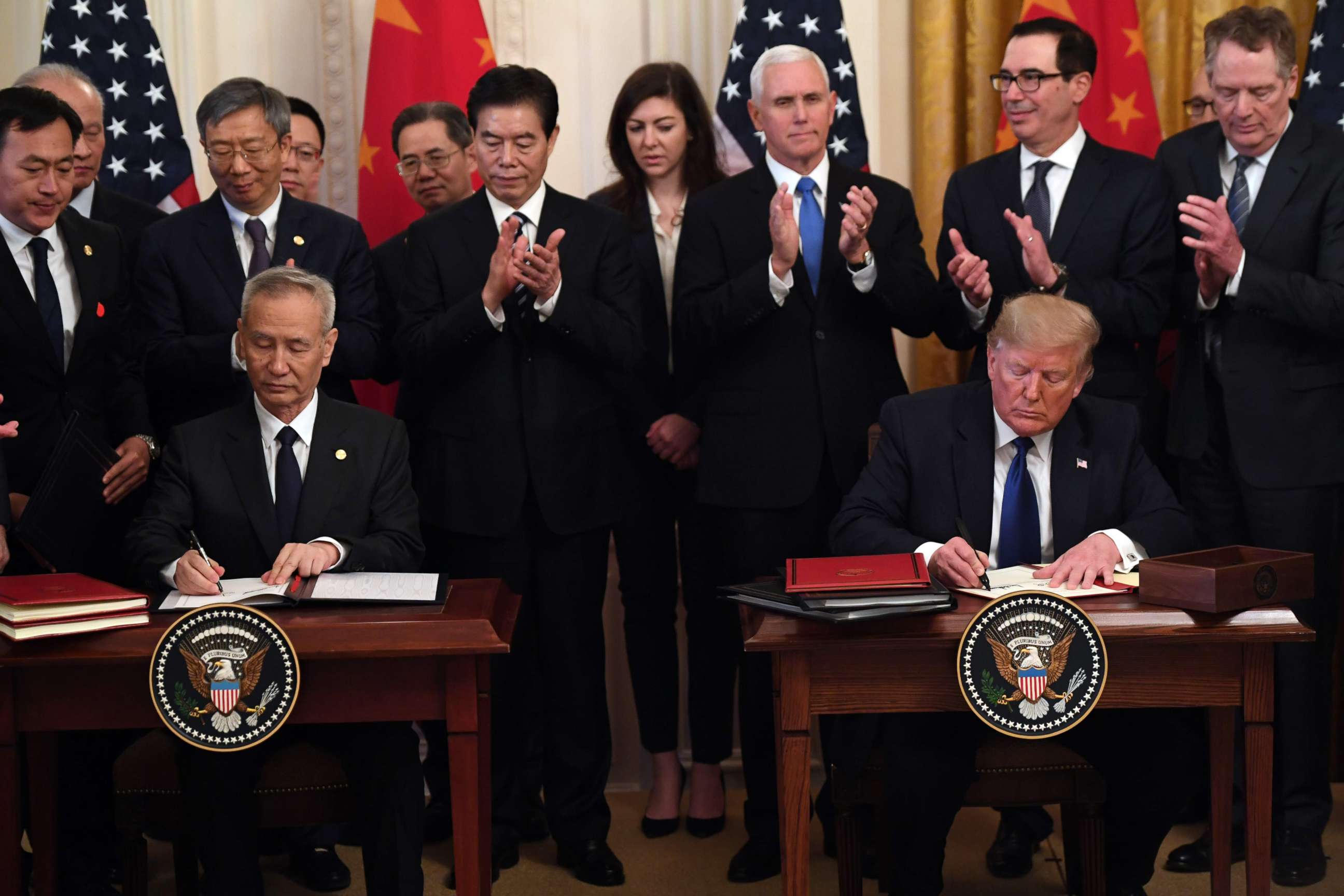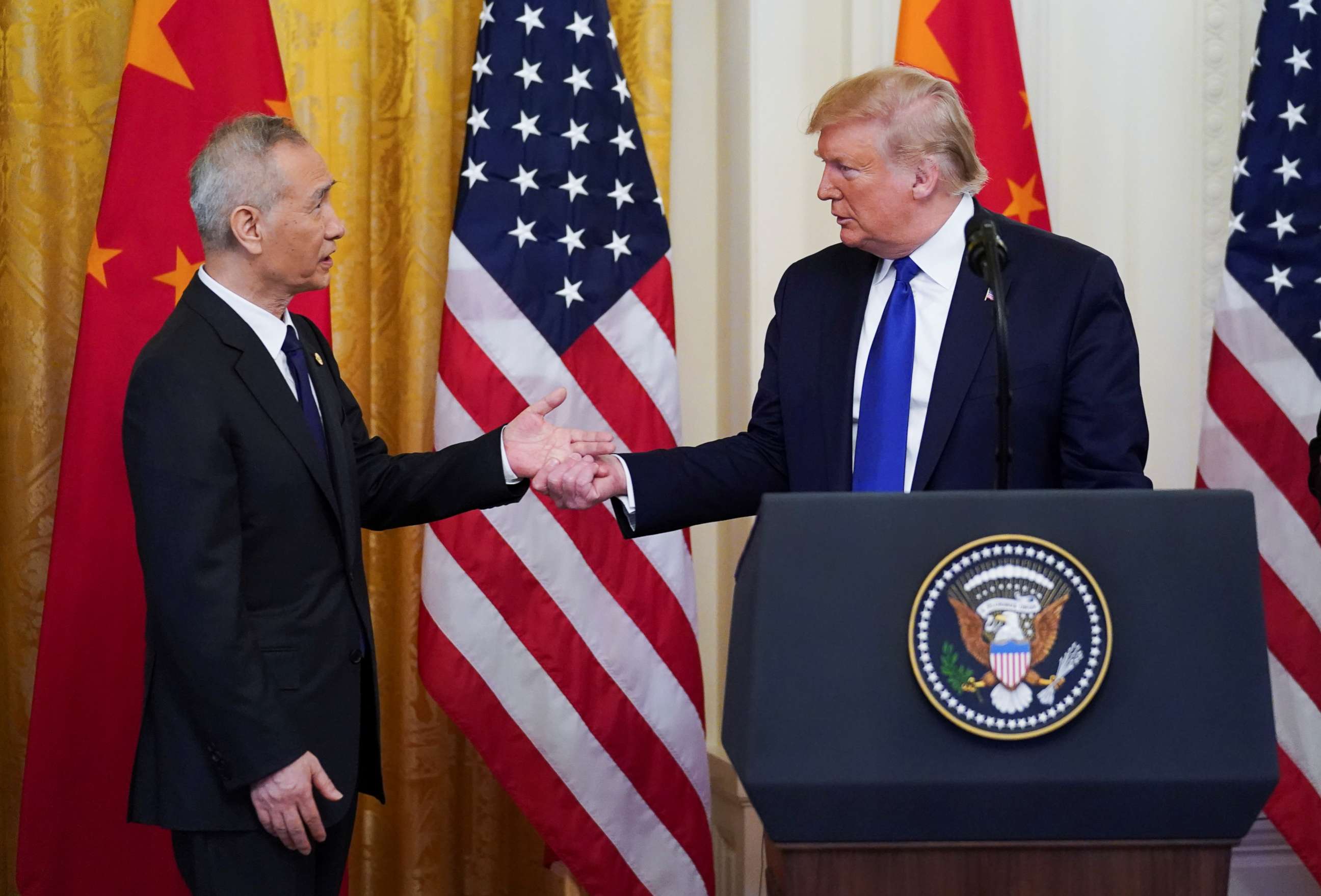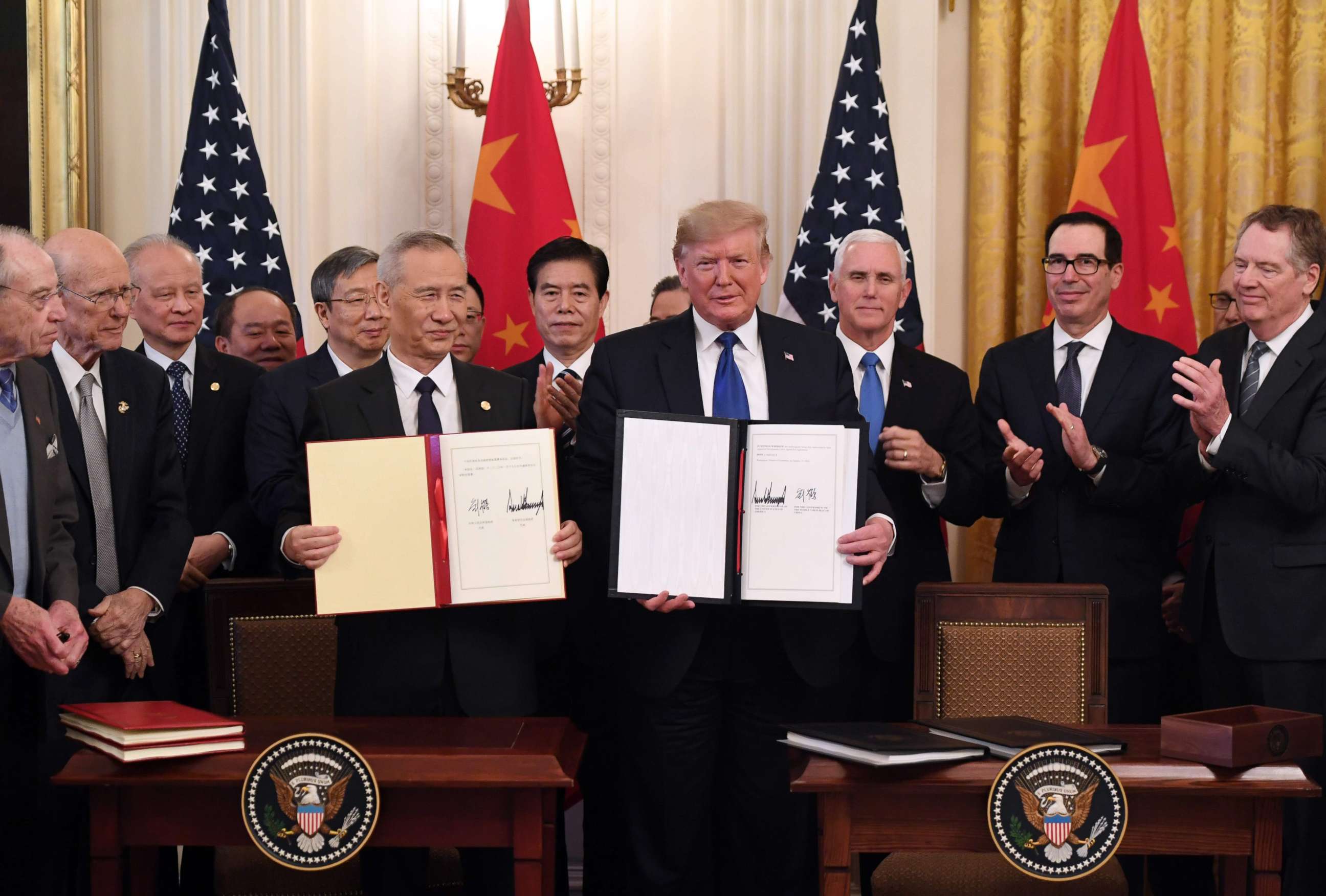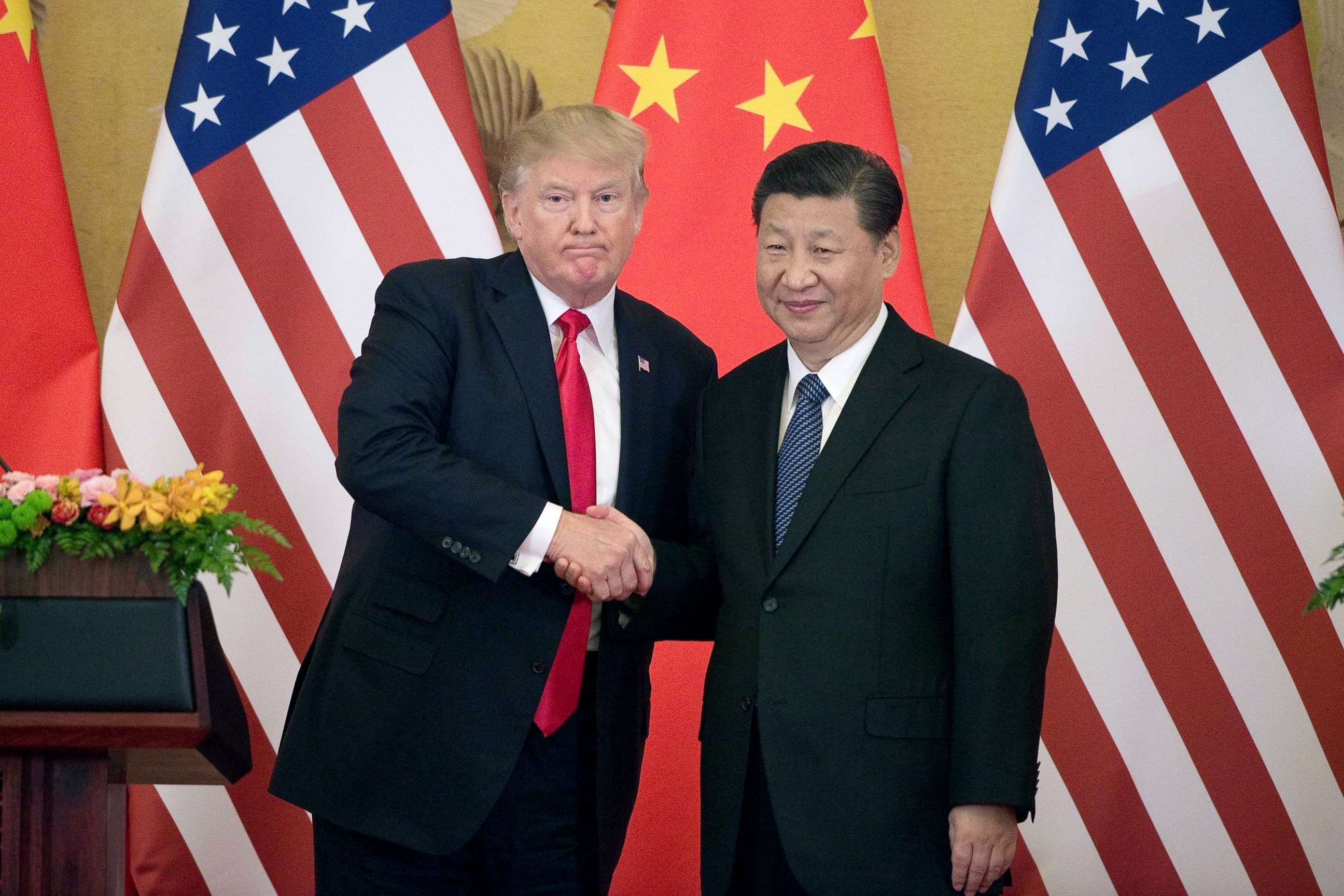President Trump signs partial trade deal with China, calling it a 'momentous step'
He was joined in the Oval Office by China's Vice Premiere Liu He.
President Donald Trump signed a partial trade deal with China on Wednesday -- joined by China Vice Premiere Liu He -- a so-called "phase one" agreement representing a significant step toward de-escalation in the nearly two-year-long trade battle
The two signed the deal against a backdrop of U.S. and Chinese flags with the president trumpeting it as a "momentous step" toward a more fair trading future between the world’s two largest economies.
But for all the pomp and ceremony, one big name was noticeably absent: China’s President Xi Jinping.
Trump had been open about his desire to sign the deal alongside his Chinese counterpart, and there were tentative plans for the two to do so at the Asia-Pacific Economic Cooperation (APEC) Summit in Chile in November. But after that summit was called off by the host, the president floated the idea of hosting Xi in Iowa -- or another location in the American farming heartland -- for a signing.

While Xi was not present, that didn’t stop Trump from offering him a direct shout out, telling the audience that Xi is "watching as we speak" and saying that he plans to travel to China "in the not too distant future to reciprocate."
The White House had downplayed Xi’s absence before the signing, with an administration official saying the ceremony taking place on U.S. soil is a victory in and of itself, and that a future meeting between the two leaders is still a possibility.
This is one of Trump's top foreign policy priorities and comes as the impeachment process moves forward, with the House poised to vote Wednesday on a resolution to send the articles of impeachment to the Senate and name the impeachment managers for the trial. Following Pelosi's announcement, Majority Leader Mitch McConnell told reporters on Tuesday that arguments in the trial are "likely to begin" next week.
The text of the U.S.-China agreement has yet to be made public, and according to an administration official, will not be released until after Wednesday’s formal signing.
But the Trump administration said China has agreed to purchase billions in U.S. agricultural products and end its practice of forced technology transfer for foreign companies that do business in China.
In an off camera briefing with reporters ahead of the signing, the top U.S. negotiator Robert Lighthizer expressed confidence that the Chinese are serious about implementing the agreement and that it will ultimately be effective in curbing China’s forced technology transfer practice.
"The answer is yes," Lighthizer said. "This agreement will work if China wants it to work. The people that I'm dealing with in China want it to work. So the answer is yes."
Still, he acknowledged that he does expect there to be some snags along the way.

Jennifer Hillman, a senior fellow with expertise in trade issues at the Council on Foreign Relations, has cautioned that China has promised such reforms in the past but subsequently failed to implement them.
"A lot of it is going to depend on whether China is promising to do things they haven’t done before and there’s no way to know that until we’ve seen the text," Hillman said. "It’s not clear how much of what China is promising is anything beyond what they’ve already promised in the past. We just don’t know."
Trump has trumpeted the agreement as a boon for U.S. farmers, who have been particularly hard hit in the trade war. The president said last month that China has agreed to ramp up U.S. agricultural purchases to $50 billion "pretty soon" and has advised U.S. farmers that they should "get bigger tractors" to meet the anticipated growth in demand.
But Hillman says the $50 billion goal for U.S. agricultural sales is "totally unrealistic" and assumes that American farmers want and can sell that much overseas.
The White House has pulled out all the stops to frame this as a victorious moment for Trump, inviting over 200 people to attend the Jan. 15 signing ceremony in the East Room of the White House and hosting a formal luncheon in the State Dining Room in honor of the visiting Chinese delegation.

Hillman said the asymmetry in having Trump alongside a lower-ranking official of a foreign government, rather than a head of state, is an odd contrast.
"In the past, trade agreements were usually signed by trade ministers rather than presidents," Hillman said. "But when the president does sign a trade agreement, it is almost always with other presidents."
Hillman said Xi’s absence also sends a message that the Chinese view the agreement as limited in scope.
"I think it means that this is a more limited agreement that doesn’t address any of the major structural issues with China," Hillman said. "Clearly what’s not included are any of the structural reforms that are at the heart of why we started this trade war in the first place, which is that China is increasingly less market oriented and increasingly state controlled."
And even as the United States and China are set to celebrate a step toward de-escalation, the trade war is not yet over and a level of uncertainty persists for consumers, farmers and manufacturers alike who have paid the price for the tit-for-tat tariffs between the two nations.
A round of U.S. tariffs, scheduled to take effect last month, was halted as a result of the agreement. A 25% tariff remains in place on $250 billion worth of Chinese imports, while the rate on another $120 billion in Chinese imports was slashed in half -- from 15% to 7.5%.

Treasury Secretary Steven Mnuchin reiterated Tuesday night that the remaining tariffs still in effect will stay in place through the next round of negotiations with the Chinese in pursuit of a "phase two" agreement.
"These tariffs will stay in place until there’s a phase two. If the president gets a phase two quickly, he’ll consider releasing tariffs as part of phase two. If not, there won’t be any tariff relief," Mnuchin said. "It has nothing to do with the election or anything else. There are no secret agreements."
While much remains to be hashed out, the "phase one" agreement provides Trump with a political chip he can point to as a point of progress, as he stumps for his reelection this year, while relieving pressure for further results in the ongoing dispute until a second term.
Still, the president said on Wednesday that negotiations for the next phase will begin "very, very shortly," adding that only after a second agreement is reached will the remaining tariffs be dropped, but not before.
Lighthizer added that the administration also has to see progress under the first phase before taking those next steps.
"We have to make sure this is implemented properly," Lighthizer said. "Any movement towards a Phase II is going to be dependent on this being implemented. We have to get this implemented properly and make sure it works."
ABC News' Benjamin Gittleson contributed to this report.




